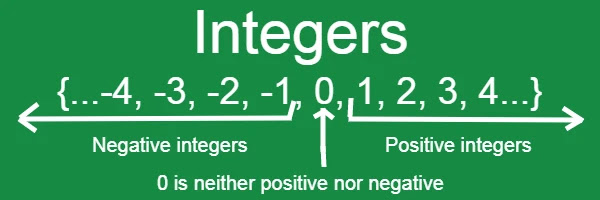Integers (Definition, Operation With Examples)
In this lesson, we shall extend our number system from whole numbers to integers.
We know that if a smaller number is subtracted from the larger one, then we get a whole number. But when a larger number is subtracted from a smaller one, we get a negative number as the answer. But there are no such whole numbers to represent them. So, to represent them we extend our whole number system.
e.g. -3, -7, -20, etc are not whole numbers.

We know, the natural numbers are 1, 2, 3, 4, ... etc. and whole numbers are 0, 1, 2, 3, 4, ... etc.
Integers
All the negative and positive number including 0 are called integers. eg. ... -8,-7, -6, -5, -4, -3, -2, -1, 0, 1, 2, 3, 4, 5, 6, 7, 8, 9, ... etc.
Now, we conclude that 1, 2, 3, 4, 5, 6, ... etc. are Positive Integers and -1, -2, -3, -4, -5, -6, ... etc. are called Negative Integers.
Note: 0 is an integer which is neither positive nor negative.
r. Height
